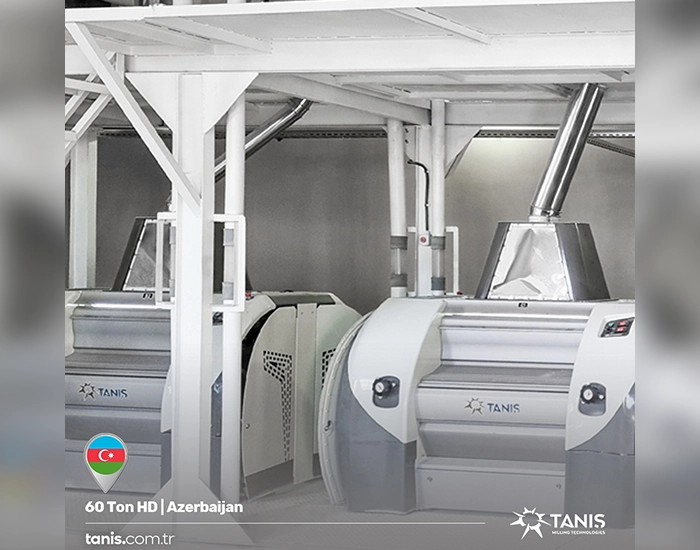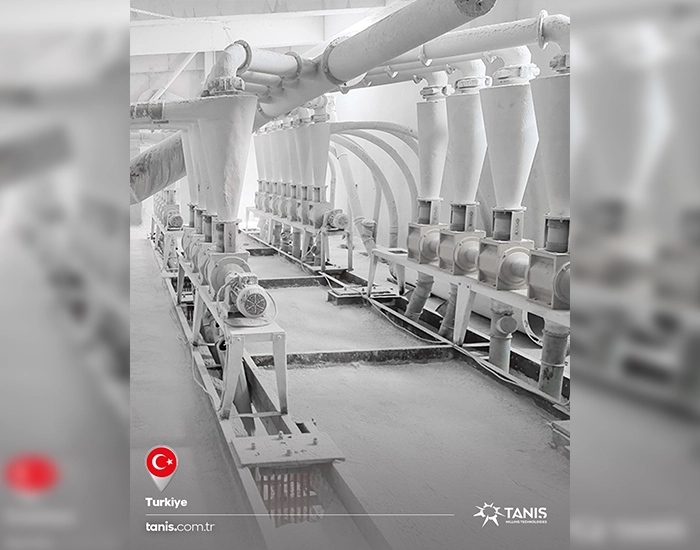Raw material usage in the mill sector has critical importance for both product quality and environmental sustainability. Environmental and social impacts in the grain production and supply process are within the responsibility and impact area of mill operations. Today, customers, investors, and regulatory bodies are increasing sustainability and transparency expectations in the food value chain. As Tanış A.Ş., with over 60 years of sector experience, we support mill facilities in developing sustainable raw material management and responsible sourcing practices. This content includes strategies and applications for mill operations to improve sustainable raw material usage and supply chain transparency.
Sustainable Agricultural Practices and Standards
For mill operations, the foundation of sustainable raw material sourcing lies in environmentally friendly agricultural practices. Conservation agriculture techniques protect soil health while also increasing productivity. These techniques include minimum tillage, cover crop usage, and crop rotation.
Water and biodiversity conservation practices are other important components of sustainable agriculture. Water-saving methods such as drip irrigation and rainwater harvesting reduce the water footprint of raw materials. Creating conservation areas, natural habitats, and buffer zones within farms that support biodiversity helps maintain ecosystem health.
Responsible pesticide and fertilizer use directly affects both environmental impacts and product quality. Integrated pest management and precision agriculture techniques minimize chemical usage while optimizing yield and quality.
Various certification standards exist for sustainable agricultural practices. These include Rainforest Alliance, GLOBALG.A.P., and regional sustainable agriculture certificates. These standards encourage farmers to adopt sustainable practices while providing mill operations with the opportunity to document responsible resource use.
Climate change directly affects agricultural production and consequently the mill sector. Climate-friendly wheat production includes both adaptation and mitigation strategies.
Carbon-sequestering agricultural practices contribute to storing atmospheric carbon dioxide in soil while also improving soil health and productivity. Minimum tillage, cover crops, and biochar applications are among techniques that increase carbon sequestration in soil.
Low-emission production techniques include methods such as improving fuel efficiency of agricultural machinery, using renewable energy, and precision fertilizer applications. These practices can significantly reduce the carbon footprint of wheat production.
Climate-resilient wheat varieties are being developed to adapt to changing climate conditions. Varieties resistant to drought, extreme temperatures, and new diseases ensure production stability while also reducing water and chemical usage.
Developing Sustainable Sourcing Policies
For effective sustainable raw material management, developing a comprehensive sourcing policy is essential. This policy should include the organization’s sustainability principles, expectations from suppliers, and long-term goals.
In the process of determining sustainability principles, the organization’s values, customer expectations, and sector standards should be considered. It is important to address environmental, social, and economic sustainability dimensions in a balanced manner.
In the policy creation and commitment development phase, top management support and participation is critically important. The policy document should contain clear and measurable goals and be formulated in a way that all stakeholders can understand.
Goal and KPI determination methodology should be based on SMART (Specific, Measurable, Achievable, Relevant, Time-bound) principles. For example, clear goals such as “sourcing 50% of wheat supply from sustainably certified sources within 3 years” should be determined.
Sustainable supplier management is a fundamental component of raw material sourcing strategy. A systematic approach is required to evaluate suppliers’ sustainability performance.
Sustainability-based assessment tools allow objective evaluation of suppliers’ environmental and social practices. Self-assessment surveys, field audits, and third-party verification mechanisms are components of the assessment process.
Environmental and social performance criteria should be aligned with the organization’s policies and goals. Factors such as soil management, water usage, biodiversity, energy efficiency, pesticide use, working conditions, and community relations should be within the assessment scope.
Risk-based supplier segmentation enables classification of suppliers in terms of sustainability performance and strategic importance. This segmentation is important for efficient resource use and identifying suppliers to focus on.
For mill operations, direct farmer relationships have strategic importance in securing sustainable raw material supply. These relationships both increase supply security and facilitate reaching sustainability goals.
Long-term farmer agreements provide income stability to producers while giving mill operations quality and quantity assurance. Such agreements encourage farmers to invest in sustainable practices.
Contract farming can be an important supply model for mill operations. This model provides market assurance to farmers while giving operations planning and quality control advantages. By including sustainability criteria in contracts, farmers’ development in this direction can be supported.
Technical support and training programs facilitate farmers’ adoption of sustainable agricultural practices. Training on topics such as soil health, water management, and integrated pest management, field days, and demonstration farms accelerate knowledge transfer.
Traceability System Setup
Traceability is the fundamental building block of sustainable raw material management. An effective traceability system enables tracking the entire journey of raw materials from source to processed product.
When determining traceability requirements and scope, legal obligations, customer expectations, and the organization’s sustainability goals should be considered. Clear definition of scope is the first step in system design.
Data collection points and methods determine the effectiveness of the traceability system. Data collection from critical points such as farm records, transportation documents, quality control data, and processing parameters and integration of this data is required.
Traceability technologies and solutions include barcode systems, RFID tags, blockchain, cloud-based platforms, and mobile applications. Technology selection should be made considering the organization’s scale, supply chain complexity, and budget constraints.
Digital Traceability Technologies
In modern traceability systems, digital technologies increase transparency and efficiency by automating data collection, verification, and sharing processes.
Blockchain and distributed ledger technologies create trust in the supply chain by providing immutable and transparent data records. These technologies enable secure access to data for all actors, especially in multi-tier supply chains.
IoT and sensor applications enable real-time monitoring of various parameters from farm and storage conditions to transportation processes. Information such as temperature, humidity, and GPS location data provides valuable insights for product quality and sustainability.
QR code and mobile traceability solutions enable consumers to easily access product information. QR codes that can be scanned with smartphones can provide information such as product origin, farmer information, sustainability practices, and quality data.
Supplier Sustainability Programs
Mill operations can create comprehensive programs to improve their suppliers’ sustainability performance. These programs both support suppliers’ development and spread sustainability throughout the supply chain.
Supplier training and capacity development accelerate the adoption of sustainable practices. Approaches such as farmer schools, field days, online training platforms, and one-on-one consulting provide knowledge and skill transfer.
Sustainability standards support facilitates suppliers’ understanding and implementation of certification requirements. Support in areas such as documentation, record keeping, and internal auditing accelerates the certification process.
Common goals and continuous improvement approach strengthen cooperation with suppliers. Annual evaluations, improvement plans, and regular feedback ensure continuous development of sustainability performance.

Fair Trade and Social Responsibility
In sustainable raw material sourcing, the social responsibility dimension is also important. Fair trade principles contribute to both economic and social sustainability by providing farmers with fair prices and long-term business relationships.
Social standards and working conditions ensure protection of human rights in the supply chain. Standards and audits should be implemented in areas such as occupational health and safety, fair compensation, prevention of child labor, and combating discrimination.
Community contribution and local development projects increase the welfare of supplier communities and establish long-term relationships. Support in areas such as education, health, and infrastructure creates social value.
Tanış A.Ş. Sustainable Raw Material Solutions
Sustainable Raw Material Assessment and Consulting
As Tanış A.Ş., we offer comprehensive assessment and consulting services to develop sustainable raw material management for mill facilities:
Supply Chain Sustainability Assessment: We analyze your existing supply chain structure and sustainability performance to identify development areas and opportunities. We prepare a business-specific assessment report in light of sector benchmarks and best practices.
Sustainable Sourcing Strategy Development: We create comprehensive sustainable sourcing strategies in line with your organization’s vision, goals, and market requirements. We provide support in policy development, goal setting, and action plan creation processes.
Risk Analysis and Opportunity Identification: We comprehensively evaluate environmental, social, and economic risks in the raw material supply chain and develop proactive management strategies. At the same time, we help create competitive advantage by identifying sustainability-focused opportunities.

Frequently Asked Questions
Sustainable raw material sourcing requires an evaluation methodology covering various dimensions. Environmental indicators (water usage, carbon footprint, biodiversity impacts), social factors (working conditions, community relations), and economic sustainability (farmer incomes, local economy contribution) should be within the assessment scope. For monitoring, supplier surveys, field audits, third-party verification mechanisms, and digital traceability systems can be used. KPIs should be determined and regular reporting and evaluation should be conducted.
Sustainable wheat sourcing may initially bring additional costs (certification fees, traceability systems, supplier development programs, etc.). However, in the medium and long term, it provides various returns: Brand value and customer loyalty increase, access to premium product segments, reduced supply risks, operational efficiency, reduced legal compliance costs, and easier access to financing. For a typical mill operation, the payback period for sustainability investments varies between 2-5 years.
Conclusion and Call to Action
Sustainable raw material sourcing has strategic importance for the long-term success of mill facilities. The balance of environmental responsibility, social impact, and economic sustainability strengthens brand value while increasing businesses’ competitiveness. As Tanış A.Ş., we are proud to be a strategic partner in mill facilities’ transformation journey.
